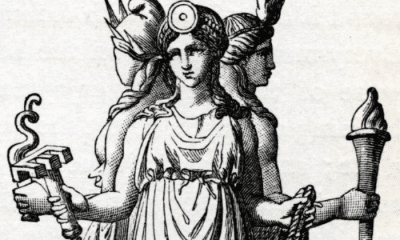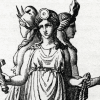
Greek
Hestia: Goddess of the Hearth
Hestia: Goddess of the Hearth
Hestia was one of the twelve great Olympians but was so removed from the drama of the other gods that she was sometimes forgotten about altogether. Keep reading to discover the truth.
The Greek pantheon was full of big personalities, epic quests, and scandalous schemes. The gods and goddesses of Olympus were known for their affairs and hot tempers as much as for the blessings they could give their worshippers.
But in the middle of the shifting alliances and in-fighting of the Olympians, there was one goddess who was completely removed from the drama around her.
Hestia, the sister of Zeus, was the constant calm centre of his household. Share on XShe never married and had no scandalous affairs. She took no sides in the fights between her kin, even in the Trojan War.
In fact, Hestia was largely absent from all the goings on of Mount Olympus.
She was so quiet and unobtrusive that she was sometimes forgotten entirely.
But even though she rarely left her place in her brother’s house, Hestia’s reach extended throughout the Greek world.
She was the goddess of the hearth, and keeping her brother’s home fires burning was her chief priority.
But this domestic role put her, quite literally, in the centre of every home, temple, and city of Greece.
Hestia, the unassuming goddess of the domestic fire, was arguably the most important goddess of them all!
Hestia and Her Siblings
Hestia was one of the six children of the Titans Rhea and Chronus.
Chronus had been told that one of his children would someday grow strong enough to take his place as the king of the gods. As a precaution, he swallowed each of his wife’s children as they were born.
Rhea deceived him, however, and hid her sixth child, Zeus. When Zeus grew to adulthood he returned to free his siblings and challenge his father’s claim to the throne.
Hestia had been the first born of Rhea’s children, which meant that when Chronus regurgitated his offspring she was the last to be disgorged. This made her simultaneously the oldest and youngest of the siblings.
There is little description given of what role Zeus’s sisters played in the Titanomachy. One account says that Hera was sent to the safety of Oceanid’s palace at the edge of the world, and it is widely assumed that other goddesses sheltered there as well.
After the gods won the war, though, their female counterparts joined in the ruling of the universe. Each took their individual roles.
Hera eventually married Zeus, making her the queen of the new gods of Mount Olympus. Demeter gave birth to a daughter, Persephone, by Zeus and took on the role of goddess of grains and the harvest.
As the gods settled into rulership, both Poseidon and Apollo petitioned Zeus for his sister’s hand. Hestia, however, was not interested in being the bride of either her brother or her nephew.
Instead, she stood before her brother the king and swore a solemn oath that she would remain chaste for all her days.
As the god of law and oaths, Zeus accepted her vow. He never tried to force her into marriage and Hestia remained a virgin goddess.
Instead of arranging her marriage, Zeus brought Hestia into his own household in an honoured position. She was the keeper of his fire and became the goddess of the hearth.
The Goddess of the Fireside
The hearth was not only the central place in the home, but in the state as well. As the keeper of the fireside, she was also tied to the sacrificial pyres of the temple and the fires kept alight in the civic halls of Greek city-states.
Tending the fire was a sacred duty. The home fire was meant to be kept constantly hot, and letting it go out was a dereliction of one’s duty to the family and home.
Neglecting to keep a fire burning was also a failure of one’s religious duty. The Greeks gave burnt sacrifices to their gods, so without a fire there was no way to show the Olympians the proper respect.
Hestia, then, played an important role in both her brother’s household and in the lives of the Greek people. Hestia represented not only the fire itself, but also its position as the centre of family life and domestic stability.
The civic fire of a city was an important symbol of the bonds between members of the community. Just like a family, the people in a city relied on one another and looked out for the common good.
This fire also allowed for civic leaders to make sacrifices to their patron god or goddess. These rituals were thought to be essential to maintaining the gods’ goodwill and preventing disasters.
The fire was such a central part of a city’s identity that when new colonies were established an ember would be brought from the home city’s civic hearth to kindle the new town’s own.
Such flames were meant to be kept burning throughout the day and night all year long. When they needed to be extinguished, there were specific rituals that needed to be followed to both put the flame out and relight it.
The cleansing, purification, and re-dedication of a hearth before it was ritually relit fell under the purview of Hestia’s cult. Share on XThe fires that were sacred to Hestia, therefore, protected the people from more than just cold and hunger. They could protect families, cities, and entire regions from the devastation that could come from offending the other gods of Olympus.
All Sacrifices to Hestia
As the keeper of the fires that burned the gods’ share of every meal, Hestia was closely linked to the sacrifices her peers received from humans.
Because she watched over the sites of sacrifices, it was customary for Hestia to receive the first share of any burnt offerings given in honor of the gods.
This tradition carried on through Roman times, as remarked by the famous statesman Cicero:
The goddess whom they call Hestia. Her power extends over altars and hearths, and therefore all prayers and all sacrifices end with this goddess, because she is the guardian of the innermost things.
Cicero, De Natura Deorum 2. 27 (trans. Rackham)
Hestia’s place in Zeus’s household was therefore not one of honor just for the responsibility it carried and the trust that was given to her. She was honored by receiving the first share of nearly everything mankind dedicated to the deities.
The Maiden Goddesses
Hestia was not the only Greek goddess to reject the idea of marriage. Many of the female deities were sworn virgins.
This decision was often made as a solemn oath, meaning that it would bring the goddess great shame if she were to go back on it.
The virgin goddesses were highly respected in the Greek pantheon. While the mother goddesses were important, the sworn maidens presented an ideal.
In addition to Hestia, the sworn virgins of Olympus were:
- Athena – When the goddess was young, Zeus offered her anything she asked for. One of her requests was to remain chaste forever.
- Artemis – Artemis was known to violently defend both herself and her reputation. When one of her followers insinuated that the goddess was no longer a virgin, Artemis devised a cruel punishment that ultimately led to the girl’s death.
- Astraea – The goddess of innocence and purity fled the earth during the Iron Age to escape the wickedness of mankind. She was safely put in the sky as the constellation Virgo.
- Hecate – There are conflicting accounts of whether Hecate took a vow of celibacy, but most sources seem to support the idea that she did.
In addition to these prominent figures, many minor goddesses and nymphs were also of this type. There are several stories of nymphs being transformed into trees or animals to protect them from the unwanted advances of the gods.
Daphne, for example, was turned into a laurel tree rather than having to allow herself to be caught by Apollo.
Hestia’s status as a maiden was in many ways heightened by her position as the goddess of the hearth. Share on XWomen in the Greek world, by and large, enjoyed few rights and freedoms. They were largely excluded from civic life and even the social circles of their husbands.
For the majority of Greek women their lives revolved around their home and family. In some social classes it was considered unseemly for a woman to even leave her home except to visit family or for religious ceremonies.
This was especially true for unmarried women, who were considered to be in danger of abduction or assault if they were not carefully guarded. In much of the Greek world, a young unmarried woman’s entire world consisted of her home and family.
Hestia, more than Artemis or Athena, fit the role of the unmarried Greek maiden. She dressed demurely, covering her hair with a modest veil, while her maiden nieces went hunting and to war.
As the keeper of Zeus’s hearth, Hestia had a sacred duty to stay close to home. Allowing the fire to die out in the home of the king of the gods would be a serious transgression and a failure of her assigned sphere.
Hestia, therefore, was a goddess who was largely absent from the events that involved the other gods. While they set off to war or meddled with the mortals on earth Hestia, like so many Greek women, stayed home tending the fire.
She was so absent from the stories of the other gods that Hestia was sometimes forgotten entirely. There was some debate in the Greek world over whether the twelve chief deities of Olympus included her among their number, since she was a goddess that seemed so absent from the affairs of the Olympians.
The Altars of Hestia
In daily worship, however, Hestia was very present.
As a domestic deity, Hestia had relatively few major temples. Instead, her altars were located in the places to which she had the closest ties.
Every hearth was considered to be an altar to Hestia. They were where sacrifices were made and people gathered together.
Hymns to Hestia ask her to join her followers in their own homes and around their own fires. She was given a place of honor among the families of humanity just as she was in the house of Zeus.
Hestia was also given honors in the temples of all the other gods. Every temple had a sacred fire for offering sacrifices to the god or goddess it served, and Hestia held dominion over these pyres just as she did any other.
Sometimes, therefore, Hestia was included in the iconography of temples dedicated to other gods and goddesses. Even when she was not, however, it was understood that she was the lady of the temple’s fire and would always receive a portion of any offering.
The civic fires of the cities also served as altars to Hestia. She was at the center of civic life and each city’s individual identity just as she was in the home.
On Olympus, Hestia may have remained in place in Zeus’s palace. On Earth, however, she was present beside millions of hearths.
Latin Vesta
While the Greek Hestia was largely relegated to the domestic sphere, her Roman counterpart took a much more central role in the religion of the Empire.
Like most of the Greek pantheon, Hestia had an equivalent goddess in Roman Italy. Early in their history, the Romans had combined the mythology of the Greeks with their local gods, creating their own deities that were very close to those of Greece with but a few notable differences.
The Roman equivalent of Hestia was the goddess Vesta. Like Hestia she was a maiden goddess of the hearth, but her worship was much more visible than that of the Greek goddess.
The temple of Vesta was one of the most important in the city of Rome.
Emperor Augustus had given part of his personal property to the city as a new shrine to the virgin goddess. As Vesta oversaw both domestic fires and those of civic buildings, Augustus’s gift forever linked the household of the Emperor to the state religion.
Emperors were automatically made priests of Vesta because their household fire and that of her altar were one and the same.
As a character, Vesta was as reserved and uninvolved in the dramas of the gods as her Greek counterpart. But in the religion of the Empire she played a much more prominent role than Hestia ever had.
Modern audiences are probably most familiar with Vesta through her priestesses, the Vestal Virgins.
The Vestals were some of the few full-time clerics in the Roman religion. Like their goddess, one of their primary tasks was to ensure that the fires of the temple never went out.
The Vestals were all drawn from Rome’s upper classes and upon entry to the priesthood were legally emancipated from their father’s authority. They served under the Emperor and devoted their lives to the service of Vesta.
Like their goddess, the priestesses took a vow of chastity that was binding for thirty years. The penalty for breaking this law was harsh – the woman would be buried alive in ground reserved for the most wicked.
With a shrine that was linked to the power of the Emperor and iconic priestesses serving most of their lives, Vesta was a far more visible part of public life than Hestia ever was. Her festival was one of the largest in Rome and her shrine was one of the city’s most sacred sites.
Vesta was so much a part of the fabric of Rome that she was incorporated into its founding myth. The goddess played a key role in saving the twins Romulus and Remus from death as infants.
Hestia and the Margins and in the Center
Hestia was a goddess unlike any other in Greek mythology.
She was unassuming and demure. She took no part in the scandals and schemes of her fellow Olympians and even stayed out of matters of war.
Hestia had no love affairs and held no grudges. In fact, other than her position in the household of her brother Zeus, she had few ties to any gods or mortals.
In many ways, Hestia was most like the mortal women who worshipped her. They stayed at home under the protection and control of a male relative, tending to the fire and the affairs of their own households.
While Hestia’s duties and personality put her at the margins of life on Olympus, however, she was quite literally at the center of everything.
In homes throughout the Greek world, the altar of Hestia was the hearth around which the family gathered every day. In every temple and every civic building, Hestia was invoked by the sacred fires.
She received the first share of every sacrifice, even before the king and queen of the gods.
Hestia’s position at the edges of the pantheon may have made her easy to overlook, but in truth the goddess of the hearth was more involved in the daily life of the Greek people than any other god or goddess of Mount Olympus.




